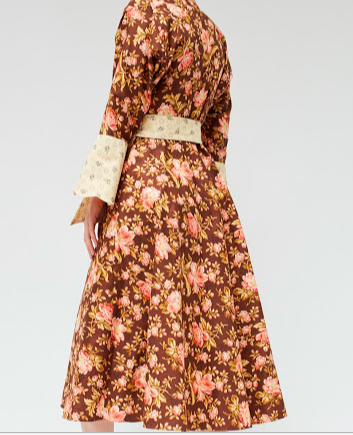
The Modest Fashionista Who Became Cutting Edge
Fast forward a few years and the story she tells goes like this: Batsheva, now married to Alexi and leading an Orthodox life on Manhattan’s Upper West Side, wanted to have a favorite Laura Ashley dress remade. The pattern alone was going to cost $250, so she decided she would have several versions of the dress sewn, using fabrics, some intended for upholstery, that she scored on eBay. And while she was at it, she decided to tweak the sleeves, adding a big pouf, and add a collar too.
Fashion followers like me know what happened next. The dresses she made began garnering notice from fashion-savvy New Yorkers who saw in them something unique and also authentic. With their hamish-looking cottons, girlish prints (florals are big in the Hay pantheon, but strawberries and teddy bears figure prominently too), they weren’t pretending to be naive or quaint—they embodied those qualities.
And the fickle fashion tribe quickly jumped on board. These days, Hay’s dresses, sometimes styled with pigtails and platform boots, are worn by the likes of Lena Dunham, Gillian Jacobs, Jessica Chastain and Natalie Portman.
So what does it tell us that a newly minted fashion darling is also an observant Jewish woman, raising her children within the sheltering embrace of an ancient tradition?
Well, for one thing, Hays came on the scene at a time of prairie-revival and Little House chic—there have been a lot of calicos, flounces and high, ruffled collars on the runway of late. So the timing was fortuitous.
But Hay’s contribution to this moment seems less like dress-up and instead engages with deeper questions of faith and observance. Because she was raised in a secular Jewish home, the rules of Orthodoxy did not always come naturally to her. Apparently, once she was baffled when she couldn’t reach Alexi for three days, unaware that in deference to a Jewish holiday she’d never even heard of, he had turned off his phone for three days. And after much discussion she says she decided not to cover her hair all the time, and only occasionally bows to convention by wearing a wig.
What strikes me as most interesting here as a follower of fashion trends, is how the whole point of modest religious dress, designed in its way to both identify its wearers as of-a-tribe and also keep them apart from the world at large, is upended by Hay’s clothing. It’s as if she’s demanding that Orthodox women—on the runway sidelines by tradition and by choice—step into the mainstream without compromising core values. What all this means for Orthodox ‘s fashion the future is anyone’s guess. But by fusing a variety of styles and traditions, Hay has done something quite remarkable on her own.
The views and opinions expressed in this article are the author’s own and do not necessarily reflect those of Lilith Magazine.
One comment on “The Modest Fashionista Who Became Cutting Edge”
Comments are closed.





I wouldn’t say the orthodox modesty rules are meant to “identify as part of the tribe” or “keep them apart”, though this may be a by-product of the practice. Rather, its focus is on dignity and privacy, as well as the inner woman–dressing attractive but not to attract.